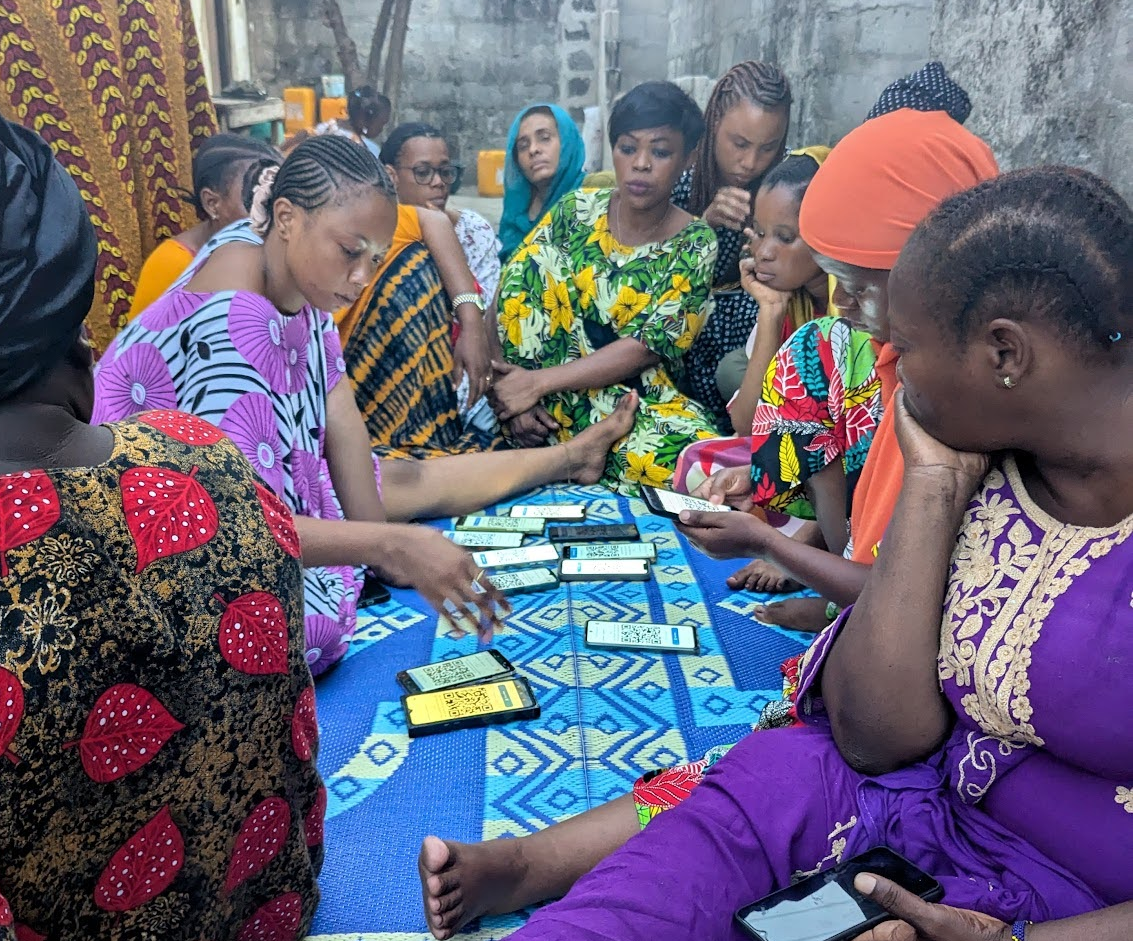In Dar es Salaam, Tanzania, the Encointer community “Nyota” has developed its own ways of leveraging digital currencies. In this article, we present how Nyota has blended its cultural habits with the new possibilities offered by the Encointer and Kusama networks. It is a story of community empowerment and bureaucracy-free cash transfers and distribution.
What is Mchezo?
Informal finance is an important cornerstone in developing economies. Examples include Hawala, an informal value transfer system mainly used in the Middle East, or informal insurance Cajas from Latin America for health and emergencies. The Rotating Savings and Credit Association (ROSCA) is one of the most widespread mechanisms. Depending on the region, ROSCAs are known as Chamas, Tandas, or Susu. Most participants of ROSCAs are women, and early examples were recorded as far back as 200 B.C. in China. In a ROSCA, members contribute to a common fund, with one person withdrawing the full amount at the start of each cycle. A ROSCA thrives on social capital, where group dynamics ensures commitment, as defaulting harms reputation and future creditworthiness.
In Tanzania, ROSCAs are called Mchezo, which means “game” in Swahili. Mchezo is widely used in communities and savings groups all over the country. The amount contributed depends on the group’s agreement, and members take turns withdrawing the entire sum. The purpose of a Mchezo varies depending on the group’s financial goals, whether for investment, emergency funds, or personal use. Some stores organize Mchezos to help their customers finance kitchen appliances or cosmetic products. Store owners understand that this approach is an effective way to attract more customers, especially since many people lack the savings to purchase these items outright.
The Kusama Mchezo
Encointer introduced the faucet feature in Oct 2023, allowing members of communities to claim 0.1 KSM per successful attendance of Encointer cycles. The Encointer protocol ensures that each person can only claim once. The faucet is donation-based and it enables a non-bureaucratic cash transfer directly into the hands of individuals of a specific region where the donations provide an additional income of real value and liquidity beyond Encointer’s community currency. This inspired the Nyota leadership to combine the faucet with local Mchezo traditions.
The first Kusama Mchezo group started with 18 members from the Nyota Community. Every 10 days, members pooled the 0.1 KSM they each claimed from the faucet and jointly exchanged them into Tanzanian Shillings (TZS) with the help of an agent who had an account on a crypto exchange. Each cycle, 72k TZS (~27 USD) was given to one member, with the expectation that they would use it to buy supplies for their business and sell goods and services for the local NYT currency, usually at a partial split with TZS. Mchezo participants become entrepreneurs and they are willing to take strategic risks with the “extra money” from the faucet because they get it on top of their – otherwise very restricted – daily budgets and it doesn’t feel like they would risk money they earned with hard labour. This spirit is expected to stimulate economic activity within the Nyota community.
One member used the funds to buy cooking oil or sugar in bulk (10 liters or more). Then the member would provide small packages of around 0.5 to 1 liter to the community, accepting NYT as partial payment (usually 30% in NYT plus 70% in TZS).
With this mechanism, new businesses and acceptance points of Nyota were established.
The fact that Kusama’s KSM token was used for the faucet complicated things. The volatility of the exchange rate between KSM and TZS made it impossible to maintain a steady payout cycle with a fixed amount of TZS. The Mchezo participants decided to share this risk and the Mchezo payout cycle sometimes had to be delayed to collect more KSM and pay out the 72k TZS to the next participant. In the future, the Encointer faucet will support stablecoins which shall protect the Mchezo from such volatility risks.
Results
The first Mchezo has created 15 new businesses. 7 of these are still actively contributing value within the community (selling tailoring services, cooking oil, flour, rice, biryani, fresh juice, hair braiding, sugar, washing soap for partial NYT payment). The total pooled and distributed amounts to 1,260,000 TZS, which is almost 500 USD in a region where many live off 5$ per day.
The Kusama faucet has been a key driver for people to join the Nyota Community, introducing them to Kusama, Nyota, and digital currencies in general. This has also sparked greater interest in blockchain technology.
The Kusama Mchezo is the first one in Dar es Salaam where contributions are made in digital currency, unlike traditional Mchezo, which relies mainly on fiat money from personal income or business activities. Here, members can use their Encointer cycle rewards, reducing financial strain compared to conventional savings rotations.
Let’s look at some numbers:
There are more positive effects to be observed in the first round of Mchezo besides the increase of the NYT turnover. Since the Kusama faucet started, the overall money flow has increased, strengthening cooperation and business relations. More businesses now accept the local Nyota currency as payment, making it easier for community members to access services and exchange goods. The Nyota leadership has observed a significant increase in livelihoods in the region and an improved economic situation.
“It’s what they say and it’s easily observed: Before the Nyota community currency and Kusama benefits, things were completely different compared to now. Now, we can see the community relationship between members is very strong, and they have an open market to sell everything they bring into the community. The use of Nyota currency has increased savings and reduced the cost of getting good products and services. Kusama and Nyota are now additional sources of income that didn’t exist before the Nyota community started.” — Alinagwe Mwaselela, Nyota Community Lead
The results from the first round of Mchezo look promising. It had a positive impact on participating businesses’ turnover and, in turn, improved the livelihood of all community members because they could afford additional goods and services thanks to partial payment in NYT, which they get as an unconditional community income. This improvement was enabled by KSM donations. Our goal is to leverage donations but multiply their impact and eventually reach self-sustainability. Further experimentation is needed to prove this possible.
Outlook
Due to the success and the great feedback within the community, a second Mchezo is on its way. Instead of having one big Mchezo, the idea is to facilitate a few smaller ones. Each Mchezo brings together a specific group of business people, e.g. six Tailors from the Mbhuarati region. On top of the Mchezo, the groups have access to a small businesses loan program, organized by the Nyota leadership. To receive a loan, a joint project with value for the participating businesses must be formulated and a collateral in NYT community currency must be deposited, driving the demand of NYT.
The Nyota community members often face precarious living conditions that make it challenging to afford everyday essentials. This financial strain can lead to unsustainable business decisions. Recognizing the link between personal well-being and business performance, the Mchezo supports its members’ personal needs, which helps them to build a more stable and productive environment. To foster mutual trust in the community, the usage of the Mchezo funds is being communicated transparently within the group.
We are looking forward to the next round of Mchezo.
You can donate KSM directly to Encointer communities of your choice now and support these experiments!
Acknowledgements
We thank Alinagwe Mwaselela for managing the Kusama Mchezo, providing the on-the-ground data and co-authoring this post. And we thank the entire Nyota community for proactively blending their cultural habits with the new digital possibilities Encointer offers.
Links and References
- https://www.investopedia.com/terms/r/rotating-credit-and-savings-association.asp
- https://en.wikipedia.org/wiki/Rotating_savings_and_credit_association
- https://www.rfgroup.com/caymanislands/news/blog/rotating-saving-clubs-for-small-business-owners
- https://www.e-mfp.eu/post/when-fintech-meets-traditional-informal-financial-schemes-recent-trends-innovations-digitising


